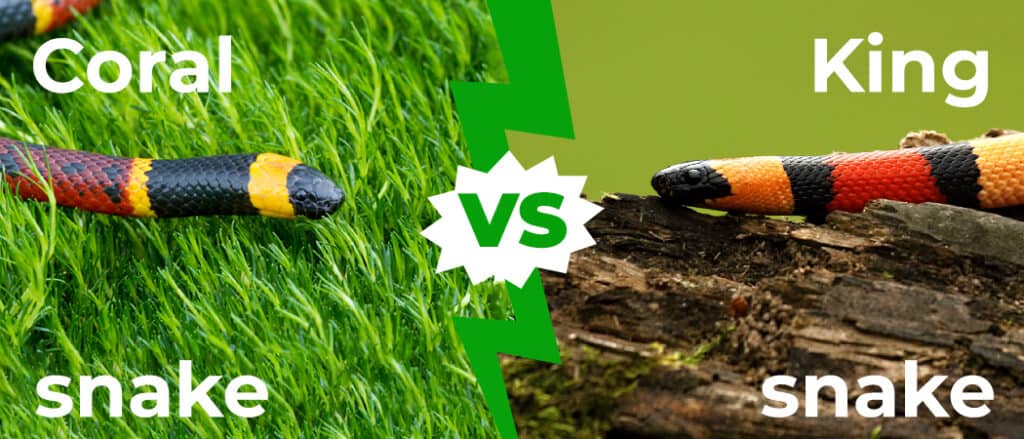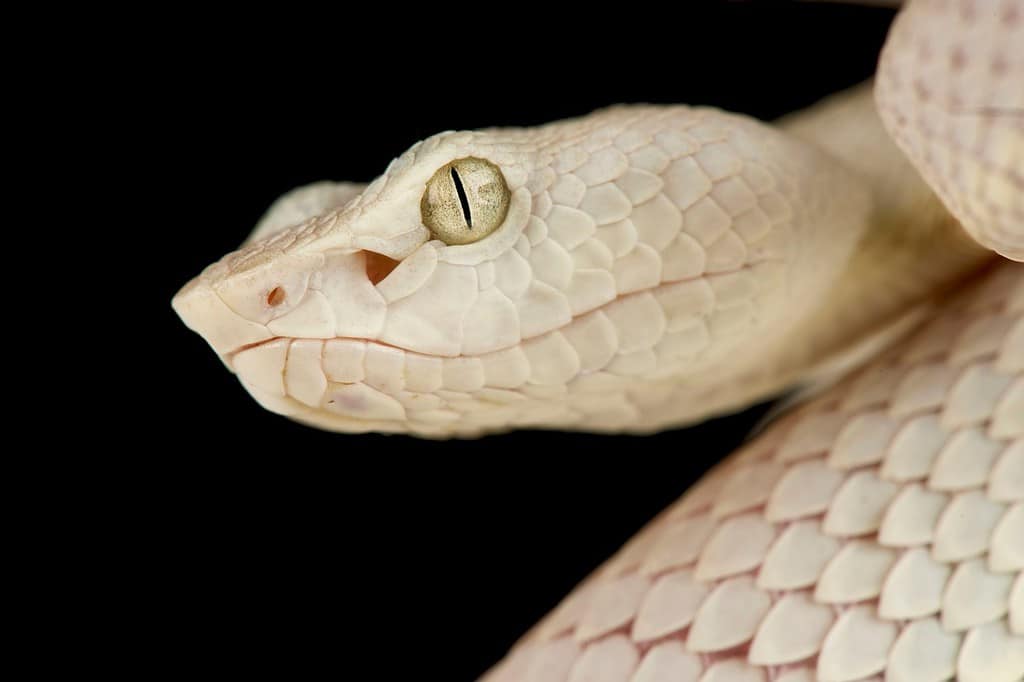With an average of 236 snake bites reported in Mississippi annually, both locals and visitors must be careful when they explore the great outdoors — even in their own backyards! The state ranks number seven on the top 10 list for most snake bites reported in 2023.
Whether you fish in the most snake-infested lakes in Mississippi or take a hike in the woods, always watch out for snakes. Today, we’ll take a look at the six most common snake bites in Mississippi for 2023. We contacted several authorities for the most up-to-date information.

Snakes inject venom through hollow fangs attached to venom glands located just under their brain.
©Audrey Snider-Bell/Shutterstock.com
Mississippi Snake Bite Data for 2023
Jenna Davis, a certified Nurse Practitioner and the Managing Director of MS Poison Control Center told AZ Animals the following regarding snake bites in Mississippi:
“Over the last 5 years (2019-2023), the MS Poison Control Center received an average of 146 calls about human exposures to snakes each year. The vast majority of these occur in warmer months. They typically occur between March [and] October. So far in 2023, we have 135 human exposure cases to snakes:
- Out of the 135, 36 were identified as copperheads.
- Out of the 135, 19 were identified as cottonmouths.
- Out of the 135, 24 were identified as crotaline species, but not enough information was provided to positively [identify] the snake as either copperhead, cottonmouth, or rattlesnake.
- Out of the 135, only 1 was known to be a rattlesnake. Typically, we have about a handful of known rattlesnake envenomations each year. This year was lower.
- Out of the 135, 9 were identified as nonvenomous.
- Out of the 135, 43 were unknown type (not enough information provided to classify [the] snake).”
This information is current as of November 21, 2023. Of the 135 on record, Davis also told us that 49 snake bites in Mississippi in 2023 required medical professionals to administer antivenom. Thankfully, none of the bites reported so far resulted in death.
Record-Breaking Snake Bite Numbers in the Last 5 Years in Mississippi
According to the data from Davis, the worst year for snake bites in Mississippi in the last five years was a total of 166 in 2020. She also gave us the following information regarding snake bites per species (as confirmed by positively identifying the snake) over the last five years:
- Most rattlesnake bites — 8 in 2020
- Most copperhead bites — 36 in 2023
- Most cottonmouth bites — 25 in 2021
Keep in mind that these snake bites in Mississippi are only those reported to poison control. Other sources claim the yearly average in the state nearly doubles what Davis provided us.
#6 Rattlesnake Bites — 1

Timber rattlesnakes claim the title of most venomous snake species in the United States.
©Frode Jacobsen/Shutterstock.com
With four different species of rattlesnake in the state, it’s rather surprising to hear their bite numbers so low in 2023. Really, rattlesnakes make up only 10% of snake bites in Mississippi annually. Perhaps this is because these snakes warn you well ahead of time of their presence. When you hear that rattle that strikes fear into your heart, stop moving and visually locate the snake. This way, you can slowly back away and continue in the opposite direction.
The four rattlesnake species include two pygmy varieties, the Western pygmy and the Dusky pygmy. The other two are the Eastern diamondback and Timber (or Canebrake) rattlesnakes. Of the four, the timber rattler is the most dangerous and aggressive. Most rattlesnake bites that do occur in Mississippi happen when a person attempts to kill or otherwise harass the snake.
#5 Nonvenomous Snake Bites — 9

Of over 50 snake species that live in Mississippi, only seven possess venom. So, it’s no surprise that a small percentage of reported bites each year come from nonvenomous snakes. Many harmless snakes in the state look similar to their dangerous cousins, however. For instance, three species appear quite similar to the venomous Harlequin coral snake. They include the Eastern milksnake, Scarlet kingsnake, and the Scarlet snake. The important thing to remember with these snakes is the old saying, “Red touches black, you’re ok, Jack. Red touches yellow; it kills a fellow.” Generally, it’s best to leave snakes alone. While most Mississippi snakes don’t have venom, their bites may still be painful and risk infection.
#4 Cottonmouth Bites — 19

Cottonmouths’ name comes from the bright white tissue inside their mouth.
©Marcum Havens/Shutterstock.com
Also called the water moccasin, the cottonmouth snake is well-known, especially in the southern states. However, the venom in these snake bites is much less dangerous than others in Mississippi. Less than 1% of all snake bite deaths in the United States were from cottonmouth bites.
Perhaps the most common venomous snake in the state, cottonmouths live in every county in Mississippi. They spend a large amount of time in and around water, where they hunt fish. Most people encounter them when they swim or fish. Bites occur most often if someone steps on the snake or when a person tries to capture or kill it. While not as deadly as some, a cottonmouth bite still results in intense pain, swelling, and possibly tissue death.
Cottonmouths look very similar to several other watersnake species, as well. Thus, again, we encourage locals and visitors to always leave snakes alone.
#3 Crotaline Bites — 24

The
Crotalinae(pit viper) family consists of 155 species worldwide.
©reptiles4all/Shutterstock.com
The Crotalinae family includes all species of pit vipers. Many of the Mississippi snake bites were identified as crotaline species, but not enough information was available to determine the exact type. For the state, these bites may have been from any rattlesnake, a cottonmouth, or a copperhead.
Thankfully, for crotaline bites, as many as 50% are “dry bites,” which means bites with zero to little venom. While the bite may still cause intense pain, the venom amount is not enough to kill. Scientists suspect dry bites are purely to ward off predators. The snake does not intend to kill or eat the victim, just to get them to back off. Which, in most cases, is plenty enough to send humans in the other direction!
#2 Copperhead Bites — 36

Copperhead snakes easily blend into their environment.
©Breck P. Kent/Shutterstock.com
Easily camouflaging into the leaf litter in Mississippi’s forests, the Copperhead is responsible for 25% of all snake bites in the state. Bites from these snakes also rank number one for the most common snake bites across the United States. One study stated nearly 3,000 Copperhead bites occur each year in the country. Although the most bites per state happen in North Carolina, Mississippians are no strangers to this venomous beast. Thankfully, due to the availability of antivenom, Copperhead bites are rarely deadly, claiming only one life every three years in the U.S. Once upon a time, this species was hailed as the most popular pet venomous snake!
#1 Unknown Snake Bites — 43

Sometimes, people don’t get a good look to identify a snake after a bite.
©AbuMazna/Shutterstock.com
Roughly 30% of all snake bites in Mississippi come from unknown species. This is due to poor identification, including the person never seeing the snake or the snake making a rapid escape.
In times of panic, it’s easy to lose details. Therefore, you must always go to a hospital after any snake bite. This allows medical personnel to monitor for a reaction and administer antivenom if necessary.
The photo featured at the top of this post is © Clement Horvath/Shutterstock.com
Discover the "Monster" Snake 5X Bigger than an Anaconda
Every day A-Z Animals sends out some of the most incredible facts in the world from our free newsletter. Want to discover the 10 most beautiful snakes in the world, a "snake island" where you're never more than 3 feet from danger, or a "monster" snake 5X larger than an anaconda? Then sign up right now and you'll start receiving our daily newsletter absolutely free.
Thank you for reading! Have some feedback for us? Contact the AZ Animals editorial team.







